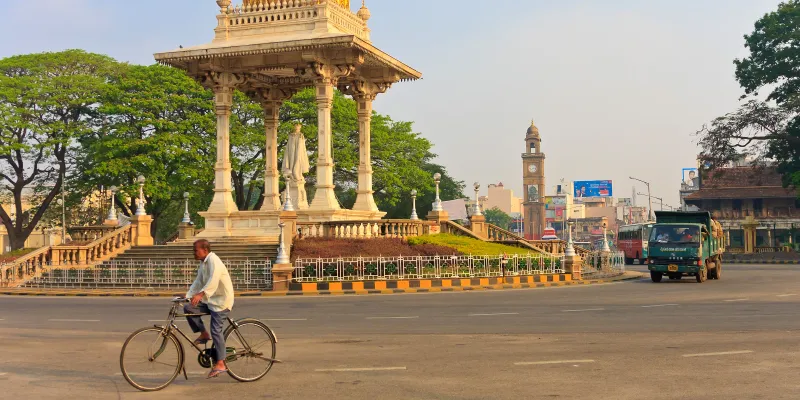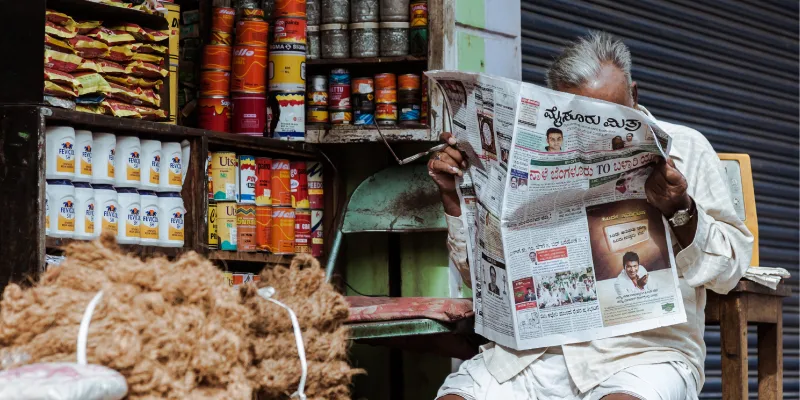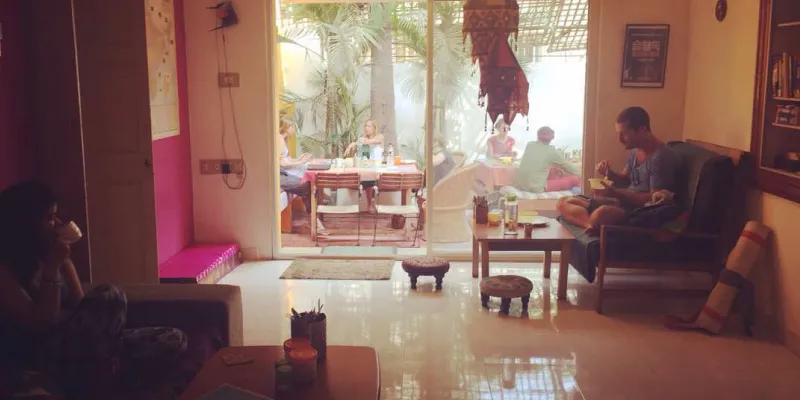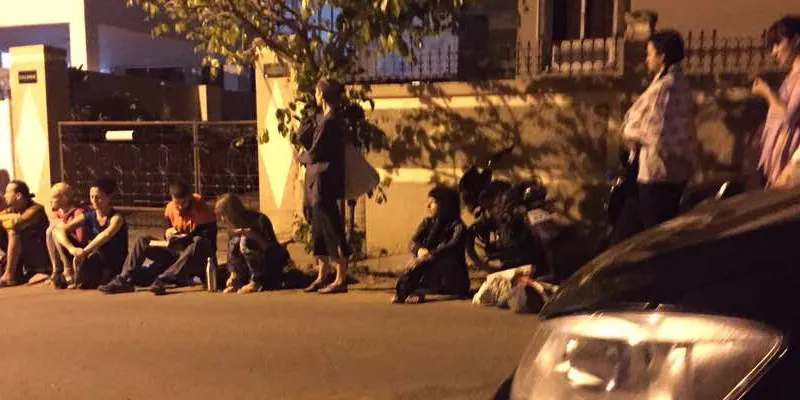Changing fortunes of many, Yoga is making Mysore do a headstand
Considering the sheer number of people who throng the city year after year to learn yoga, Mysore has become the real yoga capital of the world changing the lives and livelihoods of its residents.

When I decided to break off my two-decades-long steady relationship with Bangalore, Mysore was my rebound.
Rebound relationships have a bad name from the baggage we carry into it. Given enough trust and time, even rebounds can be nurturing.
Mysore turned out to be a more grounded cousin of Bangalore--less glitzy but more affable; similar Bangalore weather minus upper respiratory tract infection; a steady supply of pristine, fought-over Cauvery water.
Most importantly, with my newfound status as a resident of Mysore, I got to pursue my foremost love, Ashtanga Yoga and learn it straight from its foremost authority in the world Sharath Rangaswamy Jois. Imagine realising one day your rebound is, in fact, Justin Trudeau!
If you're new to the yoga world, Ashtanga Yoga is a traditional system of yoga where yoga is considered a tool to spiritual progression and asana is not practised in isolation for just the physical benefit. It is, in fact, considered the first step to the ultimate spiritual realisation or samadhi.
Ashtanga Yoga is by far the most popular yoga method in the world. Almost all celebrity yoga practitioners--from Madonna to Sting to Gwyneth Paltrow--swear by it. All the Ashtanga yogashalas around the globe follow what is called a Mysore style practice where the teachers don't lead the class. Instead, they give classes one-to-one in a group setting.
Most Ashtangis worth their sweat harbour a dream to travel to Mysore to learn it straight from the “source”. The source is KPJAYI or K Pattabhi Jois Ashtanga Yoga Institute situated in one of the pristine bylanes of Gokulam.
Late Sri K Pattabhi Jois, the grandfather of my guru Sharath R Jois, popularised Ashtanga Yoga all over the world before his passing in 2008 to such an extent that Mysore has been witnessing a steady flux of yoga students for many years. KPJAYI is considered the source of Ashtanga Yoga because Jois was the student of T Krishnamacharya, who is the father of modern yoga.

Sharath R Jois and his mother Saraswathi Jois who are carrying the tradition forward attract thousands of students during the yoga season which is typically from July to March. And it’s not just Sharath or his mother who is drawing international students to this heritage city. There are other popular yoga teachers in Mysore who conduct yoga classes during the period.
The real yoga capital of the world
Considering the sheer number of students who throng the city year after year to learn yoga, Mysore is the real yoga capital of the world though Rishikesh, with its North Indian flamboyance and muscle power, has wrested the title and kept it with it for long.
Arvind Pare, who spent 13 years in Swami Dayanand Ashram in Rishikesh to learn Vedanta, decided to make Mysore his home in 2013 because of the city’s dedication to this ancient practice. He teaches yoga philosophy and Bhagavad Gita to yoga students and believes there is no reason why Mysore shouldn’t be considered the hub of yoga in India.
“Rishikesh as the yoga capital of the world is a misnomer. There is more real yoga happening in Mysore,” he says. “Even if you look at the history of modern yoga, the credit goes to Krishnamacharya and his students who spread the tradition. Krishnamacharya was able to do that with the support from the royal family of Mysore,” Arvind adds.
According to him, though Mysore is famous for Ashtanga Yoga, there is an increasing number of students coming to the city to understand yoga philosophy, Bhagavad Gita, and also to learn Sanskrit.

This popularity of yoga has definitely changed Mysore, especially Gokulam, and helped the lives and livelihoods of the residents.
How Gokulam changed is best described in 'Churumuri', a blog on Mysore (and beyond) by the former editor of Outlook Krishna Prasad. “Gokulam today looks less like an Indian locality, more like an Olympics Games village, with foreigners of every hue spilling out of every lane and bylane, languidly walking up and down its steep inclines or zipping around on rented mopeds and scooters, when not eating ‘chow chow baath’ at Nalpak. Every other home seems to offer paying guest accommodation for yogis. Every rooftop offers ‘satvik’, Ayurvedic, and other vegetarian food for yoga practitioners. Tender coconut sellers and fruits, and health juice parlours are all over. Yoga stores, nature cure stores, wellness centres, spas, cafes, they are all here,” he writes.
Residents go glocal
Yoga has thrown open many business opportunities for the locals. Many cottage industries open up during the season and make a killing while it lasts. Even food items like peanut butter, tahini and kombucha tumble out of traditional Mysore homes. Vegetable stores stock up asparagus, avocados, and exotic herbs. The coconut seller who sells coconuts in the mornings in front of KPJAYI confesses that he sells around 500 coconuts a day (Rs 20/coconut) during the season when Sharath is teaching.
Anu Ganesh, who runs Anu’s Bamboo Hut, a very popular cafe among yoga students in Gokulam, says her life changed after she ventured into this. As I meet her at her home, she is getting ready for her first trip abroad “on work” to Finland where she would be running the kitchen at a yoga retreat.

She says when she started her cafe at the insistence of yoga students in 2004, she was in debt. Her cafe became so popular that she could pay back her debts in a month’s time. “On a good day during the peak season, I get about 30 people to have lunch thali (Rs 250/thali) at my place,” she says, “but this business is such that the next day there could be just five turning up. What you cooked anticipating a similar crowd goes waste.”
Apart from these minor hiccups of any business, Anu is content. Anu’s cafe has inspired many similar cafes to sprout in Gokulam.
With good comes bad
Yoga is serious business in Mysore but all Mysoreans are not yogis.
With the yoga season and foreign students come miscreants who want to try their hands (literally) at the female yoga students. A largely safe part of the city, Gokulam witnesses cases of groping, molestation, and other nefarious activities spiking up during the season.
Female yoga students are often encouraged to carry pepper spray, whistles, and other similar tools for safety when they walk to the shala at the wee hours in the morning for practice. At the behest of teachers and the shalas, police are often on their toes patrolling the bylanes during the hours of yoga practice. Anu says Mysore always had such Peeping Toms and offenders but they target westerners more during the season.
Perhaps another disadvantage the popularity of yoga brought with it is the escalating real estate prices. Rentals in Gokulam are double that of any other part of the city.
Anu, however, dismisses it as inevitable. “Prices do go up when the demand increases, right?” she asks.
It’s natural to suspect if yoga’s glory is limited to Gokulam alone. Truth be told, yoga could well be a passing reference in the larger scheme of things in Mysore.
It is, however, big enough for bespoke tour companies like Royal Mysore Walks, dedicated to introducing Mysore to visitors, to curate yoga tours for their clients just so they understand the city more holistically. The founder of Royal Mysore Walks Vinay Parameswarappa believes an average Joe in Mysore may not be aware of how big the yoga scene here is.

He got introduced to it through yoga students he met at the walks. It inspired him to take up yoga and also include it as part of the walks that the company conducts. “The yoga tour has many takers and we are planning to do more tours around yoga,” he says.
As we speak, Mysore is gearing up to put up a spectacular show near the Mysore Palace on the International Yoga Day, that is today, June 21. One thing is for sure though, Prime Minister Narendra Modi did not start this fire. It was always burning in Mysore.







